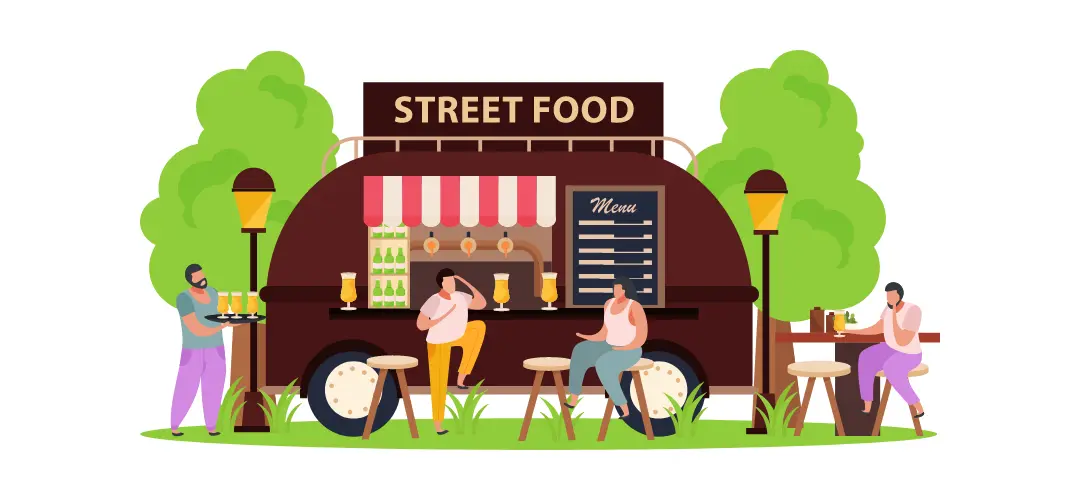
Have you ever been to a street food hub? It is a place where people, particularly those living in a fast-paced setting, go when they want to grab something to eat. People flock to street food hubs for reasons such as convenience, affordability, freshness, variety, unique experiences, and in some cases, cultural exposure.
Let’s say you are planning to put up a food cart or food truck. You want it jam-packed? Aside from offering something unique and tasty that will appeal to your potential customers’ tastes, what will make your business boom is to keep your customers engaged, and give them quick and quality service. For this reason, you can add QR Code to your marketing campaign.
What is a QR Code?
A Quick Response (QR) Code is a type of barcode that can store a large amount of information. It appears in the form of a square with small, black and white lines. There are small squares at the sides or in the corners, and they serve as the eyes that the scanners can detect before gaining access to information.
This revolutionary barcode was conceptualized by Masahiro Hara, an engineer in Denso Wave, so that the company can track automotive parts with more speed and efficiency during production. In later times, QR Codes have started to perform more complex functions, but those that would make activities easier for their users.
Information and other activities can be accessed from QR Codes using a functioning scanner. These scanners can now be downloaded in smartphones, so there is no need to buy a specialized device just for this purpose. Examples of the things you can do with QR Codes include:
Benefits of using QR Codes in street food hubs

Your food cart or food truck can benefit a lot from using QR Codes. Here are some of the features of QR Codes that can help you:
- Streamlined ordering process. Through scanning by smartphone, QR Codes can take the customers to a landing page where they can gain access to the menus for the day and choose what to order.
- Reduced wait times. As QR Codes enable customers to order directly from their phones, all they have to do is to go to the food cart or food truck and grab their snacks, or they can also have it delivered right to their homes or offices.
- Contactless payment. QR Codes can be integrated into mobile payments (such as Paypal, or cryptocurrency), thus, reducing physical contact and avoiding the risks of contracting viruses and diseases.
- Increased convenience. QR Codes makes it easy for customers to access menus, place orders, and other transactions, thus, improving their overall experience.
- Data tracking. QR Codes, particularly dynamic ones, have a system that can track information which is valuable for any business in making decisions. Examples are customer behavior and purchasing habits.
- Marketing opportunities. QR Codes of today are widely used in marketing campaigns. They are integrated with TV advertisements, brochures, flyers and pamphlets, and even billboard signages. Add QR Codes to your marketing campaigns and you’ll never have to worry about how to increase your customers.
QR Code Best Practices for Street Food Hubs
So you want to include QR Codes in your street food business? Here are the best practices that you can adopt for a start:
- CHOOSE A RELIABLE GENERATOR. QR Cloud is one of the most user-friendly websites to take care of your QR needs. Give it a try and enjoy a wide range of its features.
- MAKE CODES EASILY SCANNABLE. First is by proper layout. Make sure that the foreground colors are lighter than the background colors. Set the logo of your establishment to a reasonable size. Try and test scan before using. Then, place it in areas that can easily gain traffic like prominent locations in the city.
- BE CLEAR AND CONCISE. Opt for an easy to navigate landing pages, which are optimized for different devices. Contents must be clear and concise to be better understood. Create a clear call to action so that the customers can easily follow your instructions.
- ONE CODE, ONE PURPOSE. Generate a QR Code for a specific purpose only. Is it intended for the day’s menu? Is it intended for payment? Make sure that the customers can easily understand what the QR Code is for.
- MONITOR AND UPDATE. For this reason, the best thing to do is to use dynamic QR Codes. They are trackable and easily updatable without the need to reprint.
- PROVIDE INSTRUCTIONS. What are you going to scan the QR Code for? Giving clear instructions will ensure that you get the results that you are looking for.
- MONITOR USAGE AND CUSTOMER FEEDBACK. By regularly monitoring the usage of QR Codes and customer feedback, you will be able to decide what you will do with your business and how to improve it.
Case studies of successful implementation of QR Codes in street food hubs
QR Codes have made waves in the street food business in many parts of the world. Here are some examples of countries that have successfully implemented this technologies in their businesses:
- FOOD TRUCK FESTIVAL IN SINGAPORE. Vendors placed QR Codes on their food trucks and menus. This enabled their customers to use their smartphones to place their orders, pay, and access the food truck’s information.
- FOOD HUBS IN THE PHILIPPINES. The vendors place QR Codes on food stalls and menus to give customers an option to order through their smartphones, thus, reducing wait times and promoting contactless payment options. In other parts of the country, QR Codes are used to provide information about the food and help customers make informed decisions on what to buy.
- FOOD MARKET IN MELBOURNE, AUSTRALIA. The goal was to make transactions quick and contactless. The food market used QR Codes to increase customers’ convenience.
- STREET FOOD STALLS IN INDIA. The use of QR Codes was more focused on educating the customers about improving hygiene and safety standards. Information is accessed through scanning, and people will learn about the food being sold (ingredients, nutrition facts, etc.).
- FOOD COURTS IN BEIJING, CHINA. Food courts are naturally filled with people. In China, they used QR Codes for streamlining orders and payments, thus, reducing the hassle of waiting and increasing customer satisfaction.
- FOOD TRUCKS IN THE UNITED STATES. QR Codes function to promote food truck events, enabling the customers to easily locate the food trucks and learn about the food they offer for the day.
